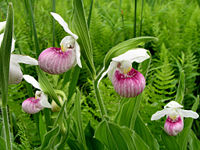Plant (organism)
| Plantae | ||||
|---|---|---|---|---|
 Cypripedium reginae
| ||||
| Scientific classification | ||||
| ||||
| Divisions | ||||
Plants, green plants, or just Plantae, is a group of living beings that have gone through several definitions along history, although, according to phylogeny concepts, it is accepted today that they are the organisms which belong to the kingdom Viridiplantae, as a monophyletic eukaryotic group of beings with cells covered by a mostly cellulose made wall; which carry out photosyntheses using chlorophyll types a and b, present in chloroplasts; and keep their products, such as amid; therefore some algae, and all fungi and bacteria are not technically considered members of this group anymore.
The exact number of plant species is unknown but it is consensus they are more than 285,000 and some assume they may be circa 350,000. From these, only about 20,000 do not produce flowers. Trees, grasses, vines, cacti, bushes, mosses and ferns are some well known plants.
Despite Phylogeny changing many of the concepts of how plants should be classified and what divisions remain, currently plants are informally divided among four main groups called; green algae, about 8.000 species; non vascular plants, or Bryophytes, circa 20.000 species; the ferns and horsetails, or Pteridophytes, around 12,000; and seed plants, that is the largest group with 260,000 estimated species. These are split in twelve total divisions:
- Chlorophyta: part of green algae
- Charophyta: the rest of green algae
- Marchantiophyta: liverworts
- Anthocerotophyta: hornworts
- Bryophyta: mosses
- Lycopodiophyta: club mosses
- Pteridophyta: ferns
- Cycadophyta: cycads
- Ginkgophyta: ginkgo
- Pinophyta: conifers
- Gnetophyta: gnetophytes
- Magnoliophyta: flowering plants